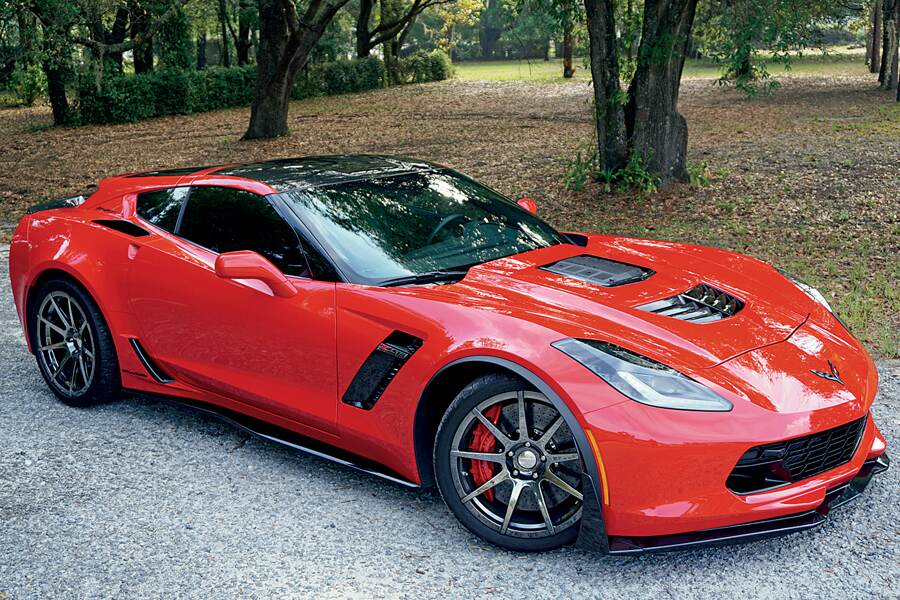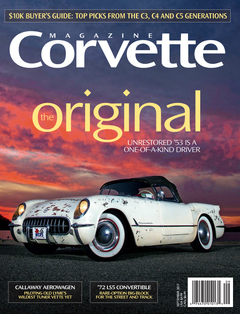“Shooting brake” may seem like a strange automotive term to anyone who grew up outside of Europe in the latter half of the 20th century. By definition a shooting brake is a dramatic redesign of a stately five-door station wagon that tends to sacrifice overall utility in the name of dashing style. But while Callaway Cars has chosen to apply the description to its new AeroWagen C7 conversion, this modern interpretation of the shooting brake manages the improbable feat of improving upon its base vehicle in every respect.
Partners in Style
Paul Deutschman, owner of Montreal-based Deutschman Design, is European trained and thus quite familiar with the history of the shooting-brake concept. He’s also no stranger to Callaway projects, having styled some of the tuner’s more notable Corvette-based vehicles—including the Sledgehammer, the C12 and the C16—over the years. Deutschman first penned the AeroWagen design in 2014, and Reeves Callaway promptly circulated the drawing to gauge the car’s appeal. Public reaction was almost uniformly positive, but Callaway Cars was busy at the time developing its line of C7 high-performance upgrades. The AeroWagen project was placed on temporary hold.

That changed in 2016, and Deutschman, along with Callaway’s Pat Hodgins, began to move forward on developing the manufacturing techniques required to build a complete AeroWagen hatch from lightweight carbon fiber. To ensure a perfect fit, the pair obtained factory hatch measurements and attachment-point locations from GM. Thanks to their efforts, the new panel will bolt directly onto any standard-production 2014-2018 Stingray, Grand Sport or Z06 coupe without modifications. It even uses all of the same factory brackets, struts, electrical connections and seals installed at the Bowling Green Assembly Plant. Perhaps most impressive, the complete AeroWagen hatch is one pound lighter than the factory unit, all while purportedly offering more (Callaway doesn’t say how much more) vertical cargo space. It’s priced at $14,990 installed at an authorized Callaway dealer, which seems reasonable enough for so thorough a cosmetic transformation.
Our Torch Red Z06 automatic test car was additionally fitted with Callaway’s SC757 engine upgrade ($18,495), black-chrome wheels ($6,280) and “Double D” stainless-steel exhaust system ($2,999), which produces an authoritative rumble at idle but quiets down to a soft purr on the highway. It was the first AeroWagen built, in late 2016, and it has since been used extensively for testing and promotional purposes, appearing on the CNBC series “Jay Leno’s Garage” as well as in a gloriously burnout-filled commercial for Mothers Car Care Products.
We were introduced to the car at this year’s National Corvette Museum Birthday Bash in Bowling Green, where it had been trucked from California showing just over 2,900 miles on the clock. Throughout the event, crowds of Corvette enthusiasts crowded around the unique C7 in an attempt to suss out the precise nature of its body modifications. Many commented that the AeroWagen looks better in person than in photographs, and after studying it ourselves from a variety of angles, we tend to agree.

When Callaway Program Manager Chris Chessnoe invited us to drive the car back to our home base in Florida at the completion of the Bash, we didn’t hesitate to accept. The last supercharged Callaway C7 we’d experienced was an SC627 coupe that we drove from Tampa to Old Lyme, Connecticut in 2014. Given our positive experience with that car, we expected great things from the 757-hp AeroWagen.
Built for Speed
We left the Bash late Saturday afternoon and followed Callaway Cars Managing Director Mike Zoner to the Nashville Airport, struggling to keep up in our rented Cruze. Once there, Zoner handed off the keys to the AeroWagen and we headed south on I-24 towards Chattanooga. It was immediately apparent that the AeroWagen’s altered rear visibility demands a certain degree of adaptation on the part of the driver. The three rear window panes provide a panoramic view, but a very vertically narrow one. We eventually found that by carefully adjusting the mirror, we could obtain a reasonable line of sight aft. Still, a rearview camera would not be an unwelcome addition here.

The AeroWagen proved very quiet over the road, where we experienced nary a hint of buffeting or wind noise. Callaway claims that the AeroWagen conversion confers a “slight” (if unspecified) improvement upon the C7’s drag coefficient, which would help to explain the car’s composure at speed. Power from the enhanced LT4 engine, meanwhile, is immediate, violent and unrelenting, as we learned during a navigation system–prompted detour around heavy Chattanooga traffic. Our GPS guided us onto I-59 to Birmingham, where traffic was light enough to push the AeroWagen well into triple-digit speeds. Thanks to its 2.3-liter supercharger and “TripleCooled” intercooler, the SC757 manages the previously unthinkable task of making a stock C7 Z06 feel logy by comparison. Torque—all 777 lb-ft of it—is immense and almost instantly available, to the point that even the Corvette’s sophisticated traction- and stability-control systems are occasionally incapable of maintaining traction at lower speeds. Fortunately the excellent Z06 carbon-ceramic brakes are fully up to the task of reining in the blown 6.2-liter when need be.
Our detour routed us east over tight, twisty, two-lane roads chock full of elevation changes. The AeroWagen’s unmodified Z06 suspension made short work of every corner, and soon we were reconnected with I-75. By now it was getting late, so we decided to spend the night in Atlanta before completing the back drive to Florida the next day. One of the more telling moments we experienced with the car came that night while we were stopped in traffic next to an AMG-badged Mercedes-Benz. The Merc’s driver rolled down his window and asked, “Is that the same car I saw Jay Leno driving on TV?” When we answered in the affirmative, he gave us an approving thumbs up before motoring away. It seems the AeroWagen’s star power even extends to the uninitiated.
The next day we encountered a heavy rainstorm south of Macon, but the AeroWagen’s big Michelin tires (standard non-Cup Pilots, fortunately) gripped the road securely and we lost very little time. Additionally, the downpour prompted one unexpected revelation: Looking into the rearview mirror, we were surprised to see that the rear window was completely dry. While this effect is likely attributable to the new hatch’s aerodynamic properties, rather than to any intentional design goal, we were nonetheless grateful for the additional visibility it supplied.

Looks That Thrill
It’s worth noting that very few gas or food stops transpired without someone peppering us with questions about the AeroWagen—such is the irresistible duende of its Deutschman-penned profile. In one instance, a gentleman asked if the car belonged to us. When we explained that we only had it for a week in order to write a magazine article, he replied, “Well, you should write a novel about it and keep it for a year!” Let the record show that we would not be averse to such an assignment.
And so it went over the course of our seven-day, 1,800-mile visitation with the AeroWagen. Camera-phone photos were snapped, queries were leveled—“Is this an experimental Corvette?” being the most common—and we were generally made to feel like celebrities. Clearly this is not a car for introverts. It is, however, an eminently practical conveyance for anyone who doesn’t mind the extra attention. The SC757-powered AeroWagen won’t win any awards for parsimony, but it is a CARB-certified, warranty-backed package that managed 20 mpg under our “enthusiastic” stewardship.

Of course, it’s unlikely that anyone is considering the AeroWagen for its fuel efficiency. Rather, Callaway’s latest creation is an outrageously capable, uniquely styled Corvette supercar that makes zero concessions in the area of practicality. In that sense, it is arguably without peer.












